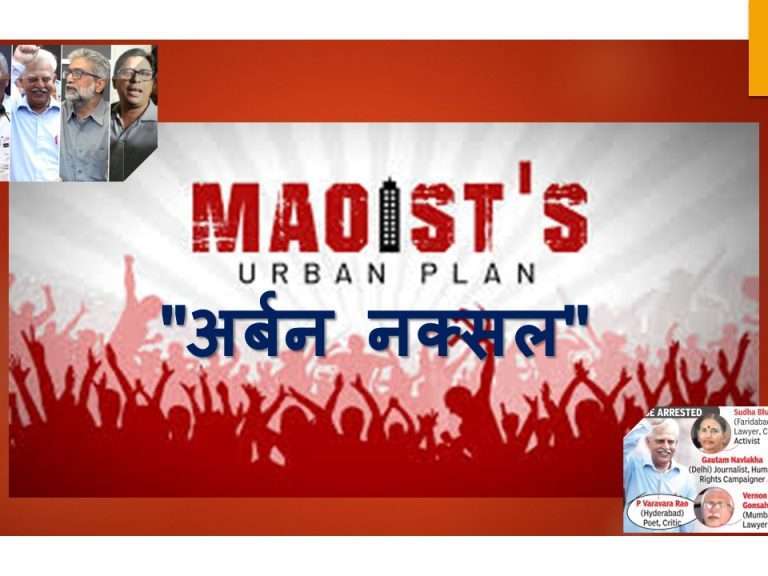
The term Urban Naxal has recently entered popular usage, however, as the concept of Urban Naxalism emerged in 2004 with the birth of the CPI (Maoist).
Social media these days is obsessed with a new term – “Urban Naxal”. However, it was only after the arrest of five activists in a multi-city raid, by the Maharashtra Police, on charges of being “urban Naxals” or “Naxal sympathizers” that the term sparked a debate about its legality and usage. , ,
Maoist ideology also calls for a strong opposition to globalization and ‘Hindu fascism’. India needs to do more to fight it.
Social media these days is obsessed with a new term – “Urban Naxal”. Well, the term has been in public discourse for quite some time now. However, it was only after the arrest of five activists in a multi-city raid, by the Maharashtra Police, on charges of being “urban Naxals” or “Naxal sympathizers” that the term sparked a debate about its legality and usage. ,
The term “Urban Naxal” can be explained in simple words i.e. people living in urban areas who understand Naxalite ideologies. The Maharashtra Police said that the arrested activists- Sudha Bhardwaj, Arun Ferreira, Vernon Gonsalves, Gautam Navlakha and P Varavara Rao, had links with the banned Communist Party of India (Maoist) and had conspired to assassinate PM Modi.
The aim of the CPI (Maoist) is to overthrow the Government of India through a people’s war. The party is considered a “left-wing extremist entity” and a terrorist organization by the Government of India. The group has been officially banned by the state governments of Odisha, Chhattisgarh and Andhra Pradesh. The party fiercely supported guerrilla warfare techniques and included many intellectuals who would spread the party’s propaganda. Activists (L to R) Arun Ferreira, Sudha Bharadwaj, P Varavara Rao, Gautam Navlakha and Vernon Gonsalves Although the term Urban Naxal has only recently entered popular usage,
The concept of Urban Naxalism, however, emerged in 2004 with the birth of the CPI (Maoist). This is an old tactic used by the Maoists to organize, mainly targeting urban centres. A large number of public which in turn would help them by providing military personnel, infrastructure and material. In the same year, the party released a document detailing how to spread its agenda in urban areas under the title “Urban Perspective”. The 53-page document not only lays out the objective of the urban revolution that the party wants to bring about but also the ways to achieve it.
For example, paragraph 3.2 of the document titled “The main objectives of our urban work” deals with the various tasks to be undertaken to take CPI (Maoist) propaganda to the urban poor. The modus operandi of the organization mobilizes the working class, as well as other classes and sections of the societies such as the semi-proletariat, students, middle class employees, intellectuals. The document mentions that the purpose of mobilization is “revolutionary agitation”. Maoist ideology also calls for a strong opposition to globalization and ‘Hindu fascism’. Urban Naxalites CPI (Maoist) Document ‘Urban Perspective’ More worrisome are the calls for military action by these masses to wage war against the government in the country.
The document states, “While the PGA and PLA perform the main military tasks in the countryside, urban mobilization also serves as a complement to the rural armed struggle. These include sending cadres into the countryside, infiltrating enemy ranks, organizing key industries , co-ordination of rural armed struggle includes sabotage operations, military support etc. This in itself is sufficient to explain how the Maoist ideology from the very beginning aims at creating an urban front which with funds and personnel will expand to the rural areas. Urban Naxalites SATP data on Left Wing Extremism in India Many who have raised concerns about the Urban Naxal phenomenon say that the activities are generally covert, making it difficult to trace and trace those behind the campaign. It becomes difficult to identify them.The invisibility of this threat makes it even more dangerous.
Left Wing Extremism has resulted in thousands of deaths. According to the South Asia Terrorism Portal, in a period of 13 years, from 2005 to 2018, 7951 people have died. Reported due to Left Wing Extremism. In 2010, it reached its peak, killing more than 1000 civilians. While there has been a gradual decline in the number of fatalities, it does not confirm that the threat from such extremism has been completely eliminated. Subsequent governments have also acknowledged the danger of this internal war.
Many have argued that the definition of Urban Naxal is too vague and classifies every critic of the current government as an Urban Naxal. While there can be debate and discussion around determining the specifics for this period, one has to accept that the threat exists and India needs to do more to fight it.
Newz Quest @parashar
